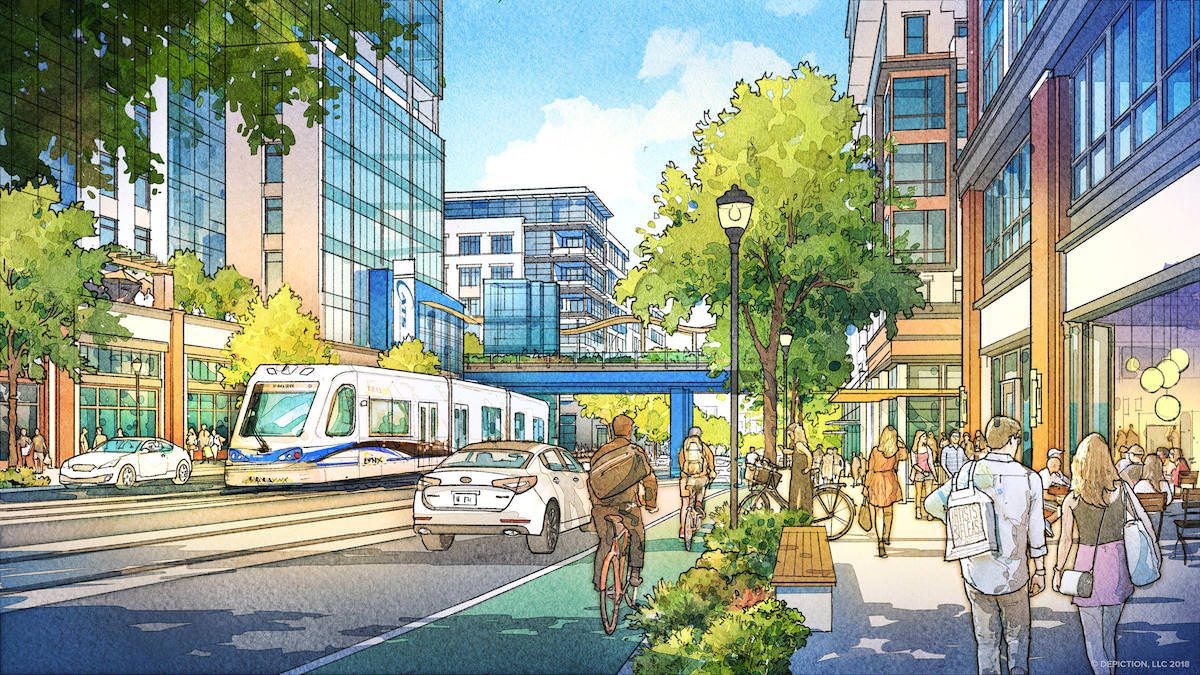Charlotte’s drive to create transit-oriented development for residents, companies, and businesses would benefit from introducing a healthy dose of TDM, or Transportation Demand Management. TDM strategies help improve livability, increase occupancy, and reduce demand for vehicles. Our Charlotte TDM team explains.
Improving Livability in Charlotte with TOD and TDM
Charlotte, North Carolina, is now the fourth-fastest growing city in the United States and the top city for Millennials. Its skyline is dotted with cranes as real estate development tries to keep up with demand among companies and new residents for offices and new homes.
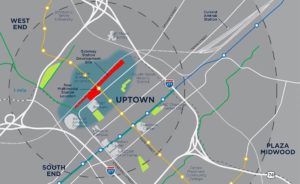
Given its exceptional growth, Charlotte is investing in its future by embracing Transit-Oriented Development (TOD) and locating a mix of uses—from living quarters to entertainment—within walking distance of public transportation. As part of its long-term plan, the city is establishing the Charlotte Gateway District, a vibrant mixed-use district uptown anchored by a multimodal transit station, Charlotte Gateway Station, that brings the city’s rail lines—both Amtrak as well as LYNX, the city’s light rail system—local buses, street cars, and ride-hailing services under one convenient roof.
To maximize this investment, it should also use Transportation Demand Management (TDM) strategies (explained more fully below), which ensure transportation infrastructure is used efficiently and effectively. Together, TOD and TDM will make uptown Charlotte and its amenities more accessible, reduce the need for driving a car, and solidify Charlotte’s reputation as a livable place.
Together, TOD and TDM will make uptown Charlotte and its amenities more accessible, reduce the need for driving a car, and solidify Charlotte’s reputation as a livable place.
Overview: Charlotte Gateway District
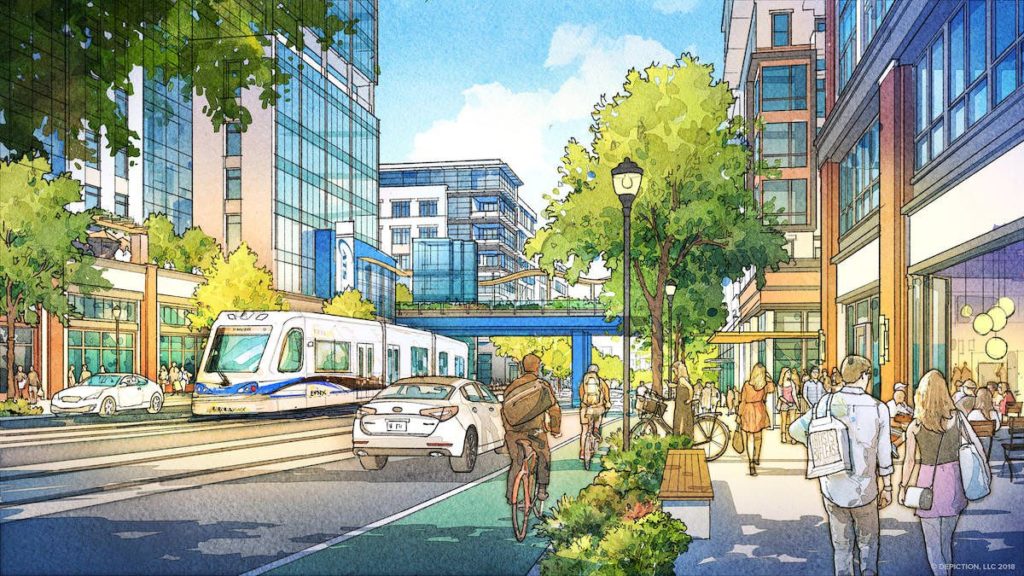
Located just to the west of the Uptown Charlotte core area, the new Gateway District is planned to revitalize a low-density section of the city into a vibrant transit-oriented, mixed-use destination.
The District’s high-density, mixed-use approach is meant to fully embrace the live-work-play model. And, from a transportation point of view, increased density and greater transportation choices will help alleviate traffic gridlock.
This section of the city also benefits from year-round events occurring at nearby Bank of America Stadium and Truist Field. The Gateway District aspires to fully embrace these event venues and provide numerous restaurant and nightlife options both before and after events while patrons traverse between venues and the new Charlotte Gateway Station.
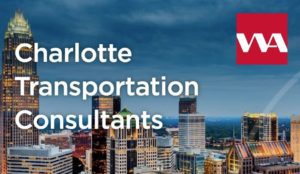
Transit-oriented projects provide opportunities to reduce auto trip generation through quick and immediate access to transit, including light rail, Amtrak, bus service, and other transportation methods.
The point is that building new and wider roads to accommodate more single-occupancy vehicles (SOVs) is not always the solution. Yet, even in a TOD area such as the Charlotte Gateway District, improvements can still be made using TDM strategies.
What is TDM?
In layperson’s terminology, Transportation Demand Management means: incentivize and help residents and commuters increase their transportation options by promoting non-SOV commuting methods, including carpools, mass transit, biking, off-peak driving, and telecommuting.
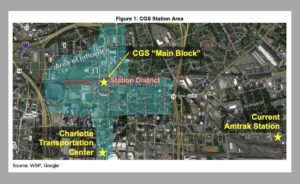
For regions that have become accustomed to single-occupancy driving, that may sound like a fantasy. But TDM is a real thing, and in many places it is being actively deployed by developers, property managers, employers, and elected officials to diversify transportation choices for residents and commuters and improve the overall transportation landscape.
Richard Petersheim, a Partner and Senior Landscape Architect with LandDesign in Charlotte, states that:
“Recently we are starting to see that high-profile development projects like Atrium Hospital and Ballantyne are requiring TDM as part of their development conditions, as well as accomplished regional mixed-use developers performing a deeper dive into the management of their parking assets. It’s an effective way to reduce traffic and parking impacts, one which we anticipate will be an integral part of large developments throughout the City into the future.”
![]()
Charlotte’s Vision: Livable and Connected
Charlotte Future, the City’s 2040 comprehensive plan, is currently under development. The planning process began in 2018 with “looking at where we’ve been, where we are, talking about what we want our community to look like over the next 20 years, and the goals we need to set to make that happen.”
The next phase continued through 2019 and analyzed “the ways our city could grow and determine the trade-offs of each way to determine the preferred option to make our community’s vision a reality.”
Preliminary growth strategies that have come out of community engagement efforts prioritize how “Residents need safe and convenient ways to get to transit stations to make light rail and express buses viable for getting to work and other important destinations.”
One of the most common perceived trade-offs of increased development is that there will be an increase in traffic congestion. Overcoming concerns about traffic congestion is a critical part of planning for future growth and development in Charlotte.
So how do you plan for future development without increasing traffic?
The experience of regions such as Northern Virginia and Denver, for example, show that the popularity of a region needs to be managed before increased SOV traffic starts to diminish a great reputation.
Case Studies in Northern Virginia: How Regulated and Voluntary TDM Plans Work
One region that has been dealing with these challenges for a while is the Virginia suburbs of Washington, D.C. “Northern Virginia” consists of a number of counties and independent cities, with Fairfax County being the most populous and, perhaps, auto-dependent of them all.
This is also a region where our transportation consulting firm, Wells + Associates, has cut its teeth on this issue. Northern Virginia’s positive experience with TDM can provide pointers to Charlotte on how to maintain and improve livability in the midst of population growth.
TDM: Regulated and Voluntary
As one key way to combat the inexorable rise in traffic, TDM can either be required (regulated) or voluntary. When counties and municipalities begin requiring developers to have TDM plans, these developers and property owners need to show that they are taking documented action to reduce car trips.
We have a lot of experience in this field, both in Northern Virginia and elsewhere, both in regulated and voluntary conditions. Our experience has shown that both regulated and voluntary TDM measures have a positive effect.
TDM is being actively deployed by developers, property managers, employers, and elected officials to diversify transportation choices and improve the overall transportation landscape. Northern Virginia’s positive experience with TDM can provide pointers to Charlotte on how to maintain and improve livability in the midst of population growth.
Over the last 10 years we have helped dozens of properties implement TDM requirements and plans. Our focus is to make sure TDM plans are delivered as integrated transportation amenities at their new developments. As these Northern Virginia projects make clear, TDM can be implemented at a wide range of development types:
- A Transit-Oriented Regional Shopping Mall (Access Tysons)
- A Live-Work-Play Mixed-Use Development (Mosaic)
- A one-million-square-foot Office Park (Towers Crescent)
- A Transit-Oriented Development (Modera Avenir Place)
Why Should Charlotte Developers Care About TDM?
One might ask, why would a developer embrace TDM solutions?
Developers agree to TDM requirements because it allows them to increase their density, improve occupancy rates, and, in some cases, reduce their parking requirements and corresponding construction costs. TDM can also become a win-win for developers in relation to their residents and the wider community.
![]()
For example, Tom Kiler, managing director at EDENS, the developer of Northern Virginia’s popular Mosaic mixed-use development, explains the impact of TDM on the wider community:
“We initiated our TDM program to be a leader in Fairfax County and help us connect more effectively to the Dunn Loring metro station and make Merrifield a more walkable community. We made sure it was woven into the fabric of how we market and promote the Mosaic District. Doing so attracted value-driven customers looking for a walkable and transit-oriented community to live, work and play. The result was that the percentage of our residents not driving increased from 32% to 41% in 4 years.”
TDM solutions also help developers sell their properties and lease them up faster. Furthermore, their tenants express how much they appreciate the transportation amenities that come with TDM solutions. So TDM becomes a tenant retention tool, too.
Developers agree to TDM requirements because it allows them to increase their density, and in some cases reduce their parking requirements and costs, so this becomes a win-win for developers, residents, and the community.
But do TDM requirements need to be, well, required? Our experience has shown that, while regulated TDM is a fact of life and can help alleviate traffic in many communities in greater Charlotte, voluntary TDM activity is also increasing. The transportation amenities that TDM brings have become so appreciated that properties without TDM requirements are voluntarily creating amenities.
For example, the Silverline Center in Tysons, Virginia, a redeveloped office building, integrated TDM solutions and transportation amenities into its revamped property.
The transportation amenities that TDM brings have become so appreciated that properties without TDM requirements are voluntarily creating amenities.
TDM Programs Are Being Integrated Into Land Use Planning Across the United States
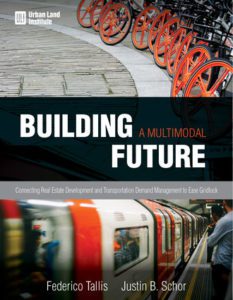 Although Northern Virginia’s Fairfax County is a great example of a jurisdiction that has seen success with its TDM requirements for developers, many other jurisdictions across the United States have had success with TDM programs.
Although Northern Virginia’s Fairfax County is a great example of a jurisdiction that has seen success with its TDM requirements for developers, many other jurisdictions across the United States have had success with TDM programs.
Urban Land Institute’s book, Building a Multimodal Future: Connecting Real Estate Development and Transportation Demand Management to Ease Gridlock, provides many real-world examples of urban, suburban, and small-town communities that have implemented TDM policies in unique contexts.
The book was co-written by W+A’s Justin Schor, who has collaborated on Charlotte-area transportation projects.
Last year, Justin was the keynote speaker outside Philadelphia at the Greater Valley Forge Transportation Management Association’s (GVF) annual awards event to share insights from the book, where he explained that TDM shouldn’t be used as a mere band-aid for traffic congestion problems. Rather, he said that “a far more effective method of addressing congestion issues is integrating TDM into land use policies, before issues with congestion arise.”
Potential Next Steps for Charlotte
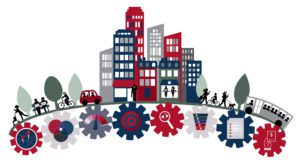 So what options does the City of Charlotte have? Charlotte has created TDM requirements for some recently approved developments in the city, including Atrium Hospital and Ballantyne.
So what options does the City of Charlotte have? Charlotte has created TDM requirements for some recently approved developments in the city, including Atrium Hospital and Ballantyne.
As part of its 2040 Comprehensive Plan, the City has an opportunity to more formally introduce Transportation Demand Management requirements into city-wide planning. Should the draft plan more formally include TDM, Charlotte stands to benefit in ways similar to other regions.
While the details are still being determined, recent practice suggests that TDM could become an integral part of future development in Charlotte—a change that would give commuters, tenants and communities transportation choices beyond the single-occupancy car ride.
Charlotte might consider using ULI’s Building a Multimodal Future as a guide. It provides nine steps to guide readers through the process of establishing TDM policies in their own projects and communities:
- Understand How the TDM Policy Fits into the Planning Fabric of the Community
- Identify Where the TDM Policy Should Apply
- Determine the Types of Developments That Should Comply with the TDM Policy
- Select an Appropriate Metric to Quantify Site-Based Success
- Set the Appropriate Goal to Quantify Site-Based Success
- Establish How the TDM Policy Will Be Monitored
- Determine Appropriate TDM Strategies for Properties Affected by the TDM Policy
- Determine Whether a TDM Plan Is Required
- Decide on an Enforcement Mechanism to Ensure TDM Policy Compliance
So far, Charlotte appears to be following these nine steps on its journey to develop a well thought-out TDM policy for new development—we are excited to see where it goes.

